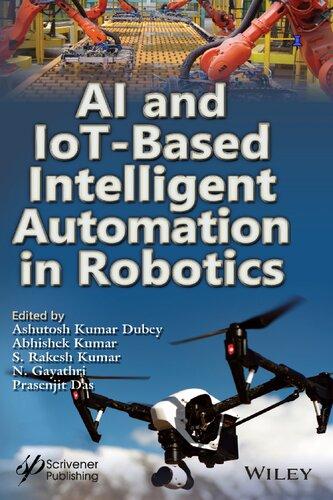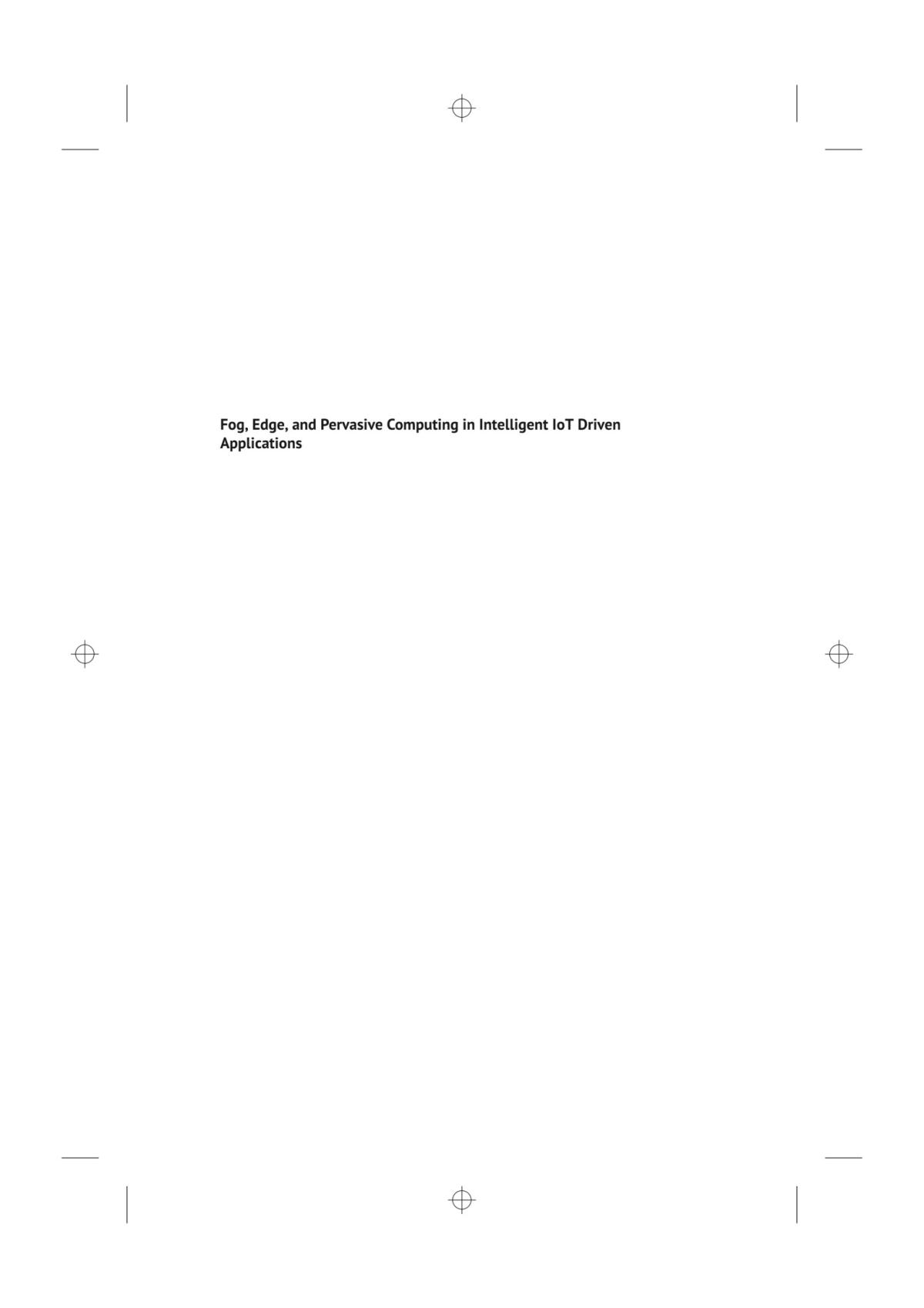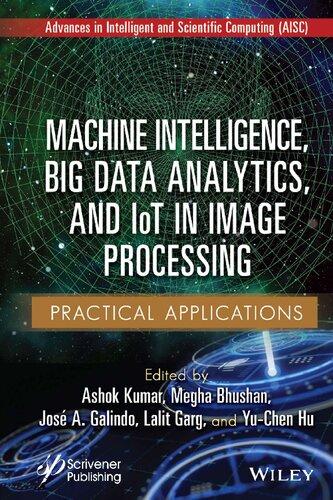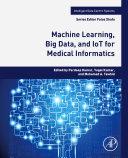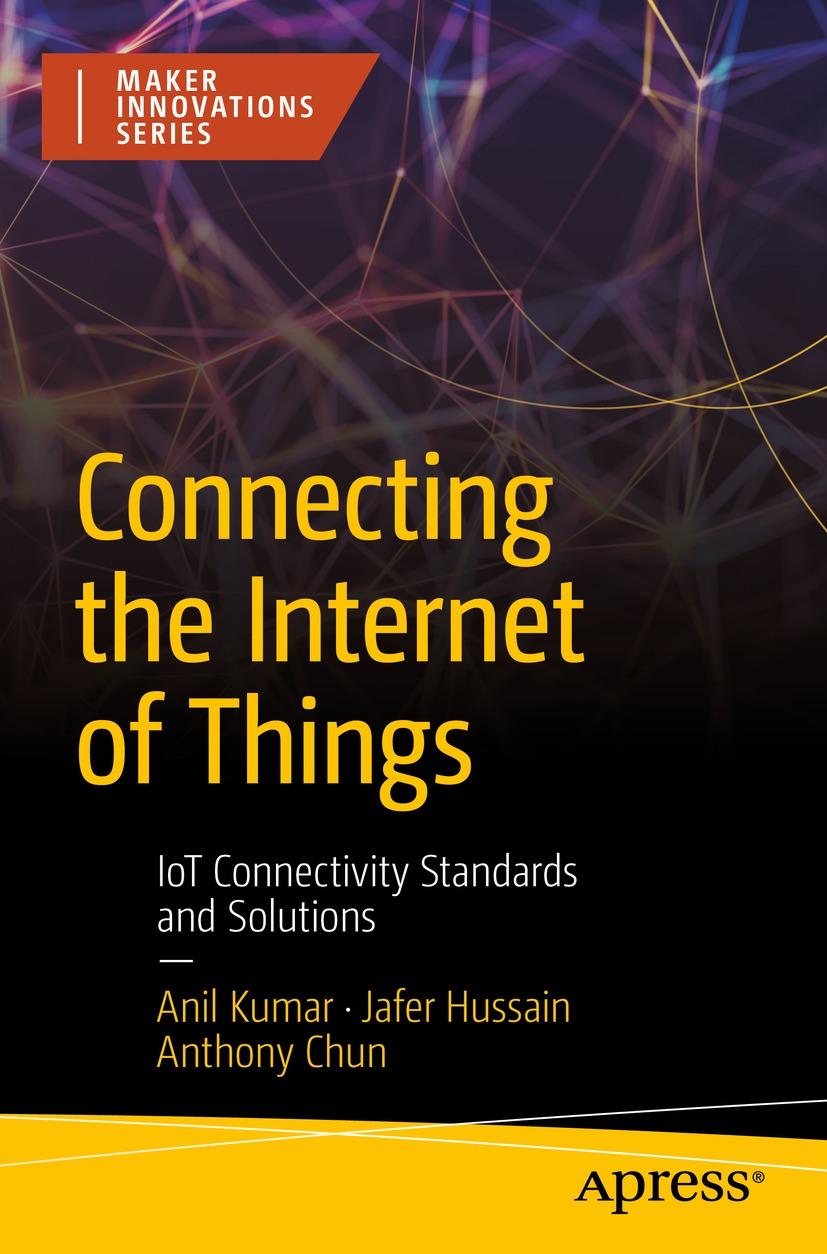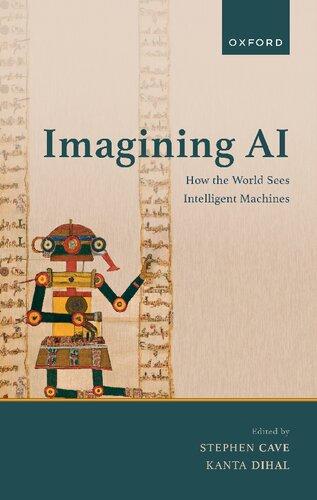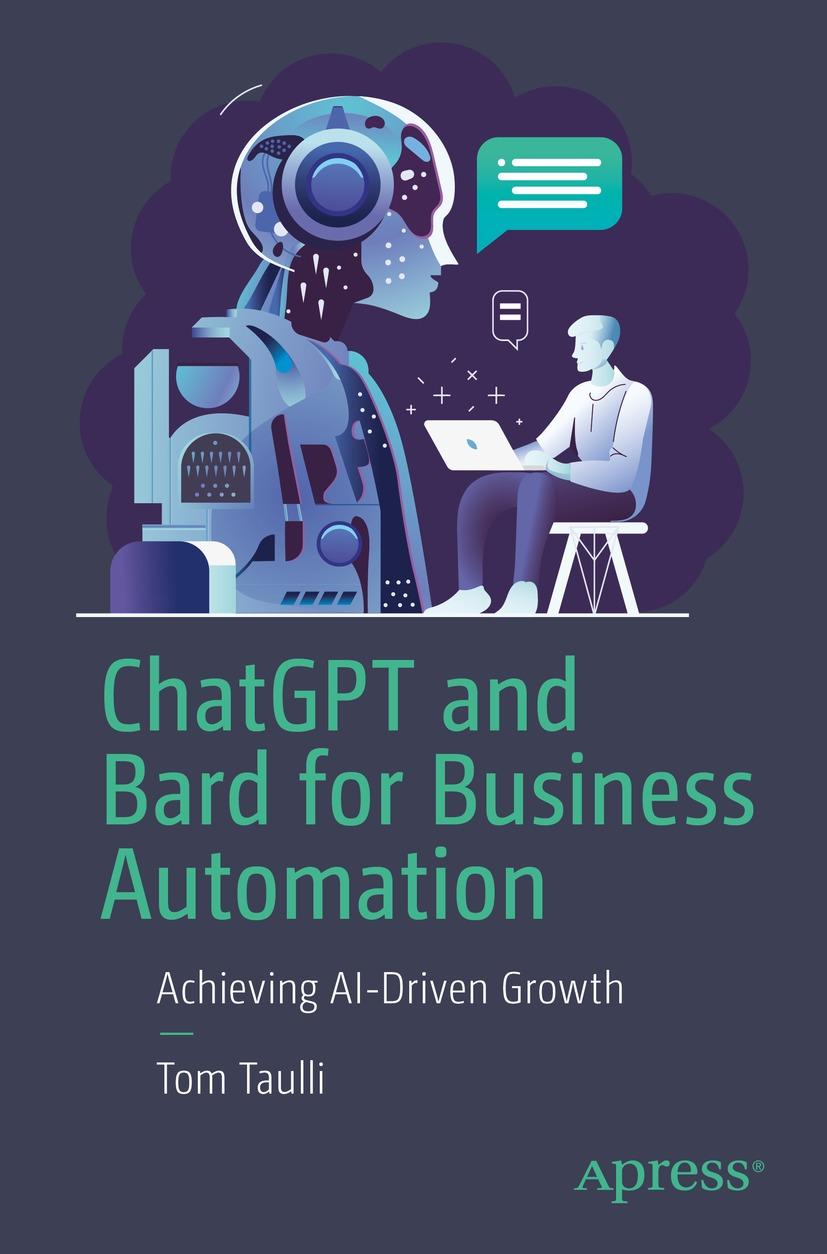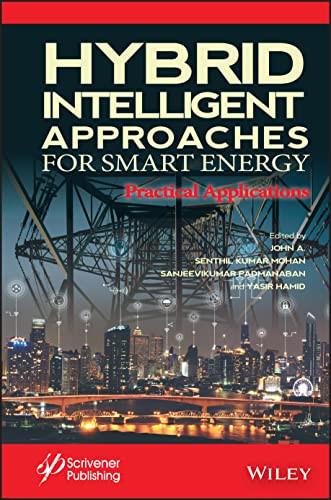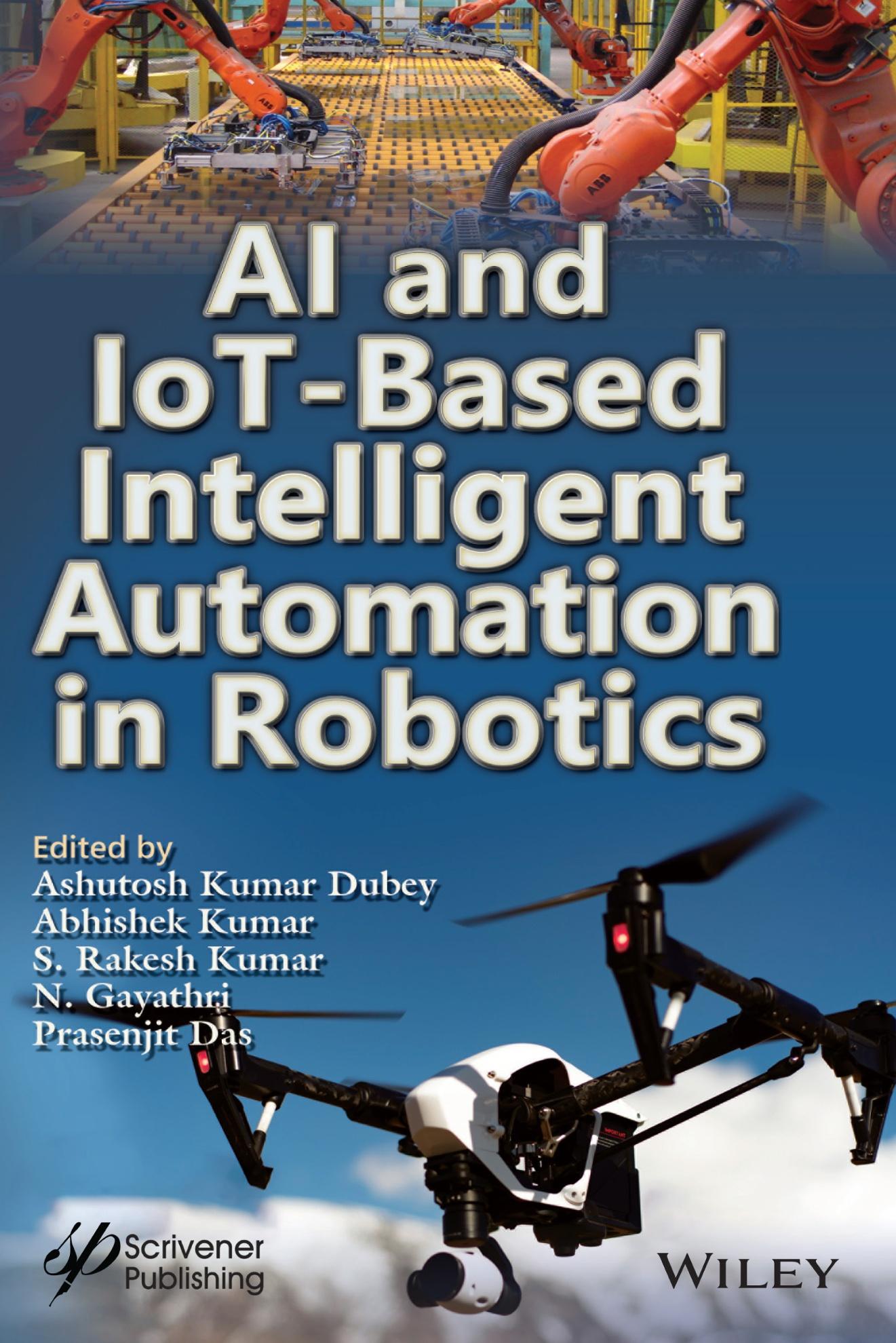AI and IoT-Based Intelligent Automation in Robotics Ashutosh Kumar Dubey
Visit to download the full and correct content document: https://ebookmass.com/product/ai-and-iot-based-intelligent-automation-in-robotics-as hutosh-kumar-dubey/
More products digital (pdf, epub, mobi) instant download maybe you interests ...
AI and Robotics in Disaster Studies 1st ed. Edition T.
V. Vijay Kumar
https://ebookmass.com/product/ai-and-robotics-in-disasterstudies-1st-ed-edition-t-v-vijay-kumar/
Fog, Edge, and Pervasive Computing in Intelligent IoT
Driven Applications Deepak Gupta
https://ebookmass.com/product/fog-edge-and-pervasive-computingin-intelligent-iot-driven-applications-deepak-gupta/
Machine Intelligence, Big Data Analytics, and IoT in Image Processing Ashok Kumar
https://ebookmass.com/product/machine-intelligence-big-dataanalytics-and-iot-in-image-processing-ashok-kumar/
Machine Learning, Big Data, and IoT for Medical Informatics Pardeep Kumar
https://ebookmass.com/product/machine-learning-big-data-and-iotfor-medical-informatics-pardeep-kumar/
Connecting the Internet of Things - IoT Connectivity Standards and Solutions Anil Kumar
https://ebookmass.com/product/connecting-the-internet-of-thingsiot-connectivity-standards-and-solutions-anil-kumar/
Feminist AI: Critical Perspectives on Algorithms, Data, and Intelligent Machines Jude Browne
https://ebookmass.com/product/feminist-ai-critical-perspectiveson-algorithms-data-and-intelligent-machines-jude-browne/
Imagining AI: How the World Sees Intelligent Machines
Stephen Cave
https://ebookmass.com/product/imagining-ai-how-the-world-seesintelligent-machines-stephen-cave/
ChatGPT and Bard for Business Automation: Achieving AIDriven Growth 1st Edition Taulli
https://ebookmass.com/product/chatgpt-and-bard-for-businessautomation-achieving-ai-driven-growth-1st-edition-taulli/
Hybrid Intelligent Approaches for Smart Energy: Practical Applications Senthil Kumar Mohan
https://ebookmass.com/product/hybrid-intelligent-approaches-forsmart-energy-practical-applications-senthil-kumar-mohan/
AI and IoT-Based Intelligent Automation in Robotics
Scrivener Publishing
100 Cummings Center, Suite 541J Beverly, MA 01915-6106
Publishers at Scrivener
Martin Scrivener (martin@scrivenerpublishing.com)
Phillip Carmical (pcarmical@scrivenerpublishing.com)
AI
and IoT-Based Intelligent Automation in Robotics
Edited by Ashutosh Kumar Dubey, Abhishek Kumar, S. Rakesh Kumar, N. Gayathri, Prasenjit
Das
This edition first published 2021 by John Wiley & Sons, Inc., 111 River Street, Hoboken, NJ 07030, USA and Scrivener Publishing LLC, 100 Cummings Center, Suite 541J, Beverly, MA 01915, USA © 2021 Scrivener Publishing LLC
For more information about Scrivener publications please visit www.scrivenerpublishing.com.
All rights reserved. No part of this publication may be reproduced, stored in a retrieval system, or transmitted, in any form or by any means, electronic, mechanical, photocopying, recording, or otherwise, except as permitted by law. Advice on how to obtain permission to reuse material from this title is available at http://www.wiley.com/go/permissions.
Wiley Global Headquarters
111 River Street, Hoboken, NJ 07030, USA
For details of our global editorial offices, customer services, and more information about Wiley products visit us at www.wiley.com.
Limit of Liability/Disclaimer of Warranty
While the publisher and authors have used their best efforts in preparing this work, they make no representations or warranties with respect to the accuracy or completeness of the contents of this work and specifically disclaim all warranties, including without limitation any implied warranties of merchantability or fitness for a particular purpose. No warranty may be created or extended by sales representatives, written sales materials, or promotional statements for this work. The fact that an organization, website, or product is referred to in this work as a citation and/or potential source of further information does not mean that the publisher and authors endorse the information or services the organization, website, or product may provide or recommendations it may make. This work is sold with the understanding that the publisher is not engaged in rendering professional services. The advice and strategies contained herein may not be suitable for your situation. You should consult with a specialist where appropriate. Neither the publisher nor authors shall be liable for any loss of profit or any other commercial damages, including but not limited to special, incidental, consequential, or other damages. Further, readers should be aware that websites listed in this work may have changed or disappeared between when this work was written and when it is read.
Library of Congress Cataloging-in-Publication Data
ISBN 978-1-119-71120-9
Cover image: Pixabay.Com
Cover design by Russell Richardson
Set in size of 11pt and Minion Pro by Manila Typesetting Company, Makati, Philippines
Kumar Modanval,
6.5.1
6.5.2
6.5.3
7.1.3
7.2
8.4.6
8.5
K.
Mild and Moderate COVID-19 Human Body
Logu, T. Devi, N. Deepa, S. Rakesh Kumar and N. Gayathri
Manju Payal, Pooja Dixit and Vishal Dutt
15
Lisha Kamala K., Sini Anna Alex and Anita Kanavalli
Mekala Ajay, Pusapally Srinivas and Lupthavisha Netam 16.1
Kavitha Esther, Akilindin S.H., Aswin S. and Anand P. 17.1
Jenifa, S. Indu, C. Jeevitha and V. Kiruthika
Preface
It is widely believed that the current technologies are not the only factors that limits the building of an efficient human-machine intelligent processing engine. The emotions and the cognitive abilities are also playing an important role in understanding the various aspects through various intelligent technologies.
Artificial Intelligence (AI) is one of the trending technologies in the recent era. The emergence of the robotics and application of AI in it brings out a significant change in the domain. Various algorithms that emerge in AI and the computational efficiency of the systems has made it possible to address a number of applications through robotics. The Internet of Things (IoT) is the important domain that plays a major role in robotics. With the aid of IoT and AI, robotics an exponential development in providing solutions to complex technical problems have been explored.
This book aims at providing an overview of robotics and the application of AI and IoT in robotics. It contains the deep exploration of AI and IoT based intelligent automation in robotics. The various algorithms and frameworks for robotics based on AI and IoT have been presented analyzed and discussed. This book also provides insights on application of robotics in education, healthcare, defense and many other fields with the utilization of IoT and AI. It also includes the idea of smart cities using robotics.
This book contains twenty-four chapters. Chapter 1 reports the introduction about the robotics. Chapter 2 explores the techniques of robotics for automation using AI and IoT. Chapter 3 descriptively investigates the role of the defense in the same technological aspects. Chapter 4 examines the role of AI and IoT based intelligent automation of robotics in case of healthcare. Chapter 5 explores the skill transfer to robots based on semantically represented the activities of humans. Chapter 6 illustrates the healthcare robots enabled with IoT and artificial intelligence for old
aged patients. Chapter 7 explores the robotics, AI and IoT in defense system. Chapter 8 describes the techniques of robotics for automation using AI and IoT. Chapter 9 discusses an artificial intelligence based smart task responder that is android robot for human instruction using LSTM technique. Chapter 10 explores the robotics, AI and IoT in medical and healthcare. Chapter 11 scrutinizes real time mild and moderate Covid’19 human body temperature detection using AI. Chapter 12 shows the role of drones in smart cities. Chapter 13 presents UAV’s in terms of agriculture prospective. Chapter 14 discussed the semi-automated parking system by using DSDV and RFID. Chapter 15 reviews on the various technologies involved in vehicle to vehicle communication. Chapter 16 explores about the smart wheelchair. Chapter 17 explores defaulters list using facial recognition. Chapter 18 introduces visitor/intruder monitoring system using machine learning. Chapter 19 provides a comparison of machine learning algorithms for air pollution monitoring system. Chapter 20 discusses a novel approach towards audio watermarking using FFT and Cordic Q-R decomposition. Chapter 21 explores the performance of DC biased optical orthogonal frequency division multiplexing in visible light communication. Chapter 22 illustrates the microcontroller based variable rate syringe pump for microfluidic application. Chapter 23 illustrates the analysis of emotion in speech signal processing and rejection of noise. Chapter 24 discusses regarding securing cloud data by using blend cryptography with AWS services.
Overall, this book is designed for exploring global technological information about the AI and IoT based intelligent automation in robotics. Armed with specific usage practices, applicability, framework and challenges readers can make informed choices about the adoption of AI and IoT based intelligent automation. It may be helpful in the development of efficient framework and models in the adoption of these techniques in different domains.
It is a great pleasure for us to acknowledge the contributions and assistance of many individuals. We would like to thank all the authors who submitted chapters for their contributions and fruitful discussion that made this book a great success. We hope the readers find value and future insights into the contributions made by the authors. This book also opens up further avenues and opportunities for the future research. We are very thankful to the team of Scrivener publishing specially to Martin Scrivener for providing the meticulous service for timely publication of this book.
Preface xix
We would like to express our deep sense of gratitude for the encouragement and support offered by our Institutions/Universities and colleagues. Last but not least, we gratefully acknowledge the support, encouragement and patience of our families.
Ashutosh Kumar Dubey Abhishek Kumar
S. Rakesh Kumar
N. Gayathri
Prasenjit Das February 2021
Introduction to Robotics
Srinivas Kumar Palvadi1, Pooja Dixit2 and Vishal Dutt3*
1Department of Computer Science Engineering, University of Madras, Chennai, Tamil Nadu, India
2Sophia Girls’ College (Autonomous), Ajmer, Rajasthan, India
3Department of Computer Science, Aryabhatta College, Ajmer, Rajasthan, India
Abstract
These days, automation plays a major role in all sectors of society and the technology of robotic automation is very much in demand along with other significantly trending concepts such as the Internet of Things (IoT), Machine Learning (ML), Artificial Intelligence (AI) and Cloud Computing. Many people are showing interest in purchasing things which have process automation; for example, do not increase speed once they reach a certain point and automatically turn off the water tank when it is about to overfill. Robotics is also the technology where when an instruction is given to the device it acts accordingly based on the user instruction. When we want the robot to perform based on the user instruction, we first have to train the device or robot with the instructions for the particular task we want to do. For example, if we give a data set to the robot for creation of coffee and we give an instruction to the robot to “Prepare Tea,” the robot doesn’t respond to the request because the request doesn’t match the available datasets in the robot. In this chapter, I will focus on a basic introduction to robots, their architecture and the equipment needed for designing robots.
Keywords: Machine learning, IoT, AI, energy, drones, nano tubes, energy, actuation
1.1 Introduction
“Robotics” or “robots” is a very popular term which we are increasingly hearing day by day. The word “robotics” was derived from the word “robot,”
*Corresponding author: vishaldutt53@gmail.com
Ashutosh Kumar Dubey, Abhishek Kumar, S. Rakesh Kumar, N. Gayathri, Prasenjit Das (eds.) AI and IoT-Based Intelligent Automation in Robotics, (1–14) © 2021 Scrivener Publishing LLC
which comes from the Slavic word “robota,” meaning slave/servant. Robots were introduced to society by George C. Devol, who generally referred to them as artificial people. Generally, robots consist of different components such as sensors, controlling devices, manipulators, power supply as well as software to perform the defined action. A combination of these characteristics forms the robot. For preparing the perfect robot we have to proceed with designing, building, programming as well as testing the robot using a combination of physics, mathematics, computational techniques, mechanical engineering, electrical engineering and structural engineering. In some of the particular scenarios the concepts of biology, chemistry and medicine are also involved based on the requirements. Generally, robot technology is used [1] in environments where a human cannot perform the action.
Many people treat robots as machines but in many of the real-time applications robots replace the person and also act as a person, such as the androids in the movies Star Wars, Terminator and Star Trek: The Next Generation. The robots capture human faces and activities and perform tasks as a person does. Even though developers are implementing many advancements in robots and using them in many applications, they are not able to develop enough common sense in them because robots perform the task based on the user’s instructions but can’t predict future actions by doing tasks in a dynamic manner. So, regarding this topic, many of the researchers are working in this domain under the research domain named “humanoid robots.”
Most of the robots which were created till now are very dangerous, boring, onerous and just plain nasty. We can find these types of robots in the medical, automobile, manufacturing, and industrial industries among others, as well as the space industry. Robots, such as the Mars rover Sojourner and the upcoming Mars Exploration rover or the underwater robotic vehicle Caribou, were designed and sent to places where humans cannot go, such as volcanoes, mars, etc., for the purpose of helping to conduct research in those particular places. On the other hand, other types of robots were designed for the purpose of entertaining small children and others. A few of them are Techno, Polly and AIBO ERS-220, which often arrive at the stores around Christmas time.
Robots are very efficient, fun and easy to design. In his book Being Digital, Nicholas Negroponte relates an excellent story that took place about eight years ago at the time of the televised premier of the Media Lab’s LEGO/Logo work at the Hennigan School. When the robot was first introduced to the children in school, they didn’t show interest in adopting it. However, in a third attempt, the children talked, played and had fun with the robot. The children asked the robot questions and the robot started
giving responses to the children. The children in the class felt very excited and had fun with the robot.
Finally, what exactly does robot mean?
Many authors gave definitions based on their understanding. There is really no standard definition of robotics. When designing the robot, every designer needs to have the following properties and features, if not it is not considered a robot [2].
The robot should have following characteristics:
• Sensing
First, robots have to recognize the surroundings and respond according to them. The robots will not behave in all the environments. We have to imbue robots with sensitivity to light (eyes), touch, pressure (like hands), chemicals (nose), sound (ears) and taste (tongue) among others. By combining all these we will get the correct working robot for the environment.
• Movement
The robot should be capable of identifying surroundings/ environment in order to perform actions such as moving its body all around the surroundings.
• Energy
Robots should be capable of identifying the power in their battery and should charge by themselves.
• Intelligence
Robots need to become smarter than humans. Those who make robots smart are called programmers. Robots should require a minimum amount of knowledge to understand and perform the task that the user instructed.
So, the definition of the term robot encompasses a sensor, controlling device, physical device, manipulator, and a programming testing device, with mechanical engineering, electrical engineering, mathematics, and a small portion of chemistry also being involved.
1.2 History and Evolution of Robots
Table 1.1 shows the origins of robotics along with detailed information of when the robots came into existence, the developer’s name, etc. Presently, there are various types of robots which are used for various environments
Table 1.1 History of the earliest robots.
Date Significance
3rd century
Robot name Inventor
BC and earlier First humanoid automata based on an earlier description Yan Shi
1st century
AD and earlier Descriptions of more than 100 machines and automata which include a fire engine, a wind organ, a coinoperated machine, and a steam-powered engine
Ctesibius, Philo of Byzantium, Heron of Alexandria, and others
c. 420 BC Robot designed like a bird, which will fly Flying Pigeon Archytas of Tarentum
1206 First humanoid robot with automata mechanism
Robot band, hand-washing automaton [11], automated moving peacocks [12] Al-Jazari
1495 Humanoid robot Mechanical Knight Leonardo da Vinci
1738 Mechanical duck which can eat, flap its wings, and excrete Digesting Duck Jacques de Vaucanson
1898 First radio-controlled device Teleautomaton Nikola Tesla
1921 First fictional automatons called robots Rossum’s Universal Robots Karel Čapek
1930s Humanoid robot exhibited at the 1939 and 1940 New York World’s Fair Elektro Westinghouse Electric Corporation
1946 First general-purpose digital computer Whirlwind Multiple people (Continued)
Table 1.1 History of the earliest robots. (Continued)
Date Significance
Robot name Inventor
1948 Simple robots exhibiting biological behaviors Elsie and Elmer William Grey Walter
1956 First commercial robot from the Unimation company
1961 First installed industrial robot
Unimate George Devol
Unimate George Devol
1967 to 1972 First full-scale humanoid intelligent robot WABOT-1 Waseda University
1973 First industrial robot with six electromechanically driven axes
1974 First microcomputer controlled electric industrial robot, IRB 6 from ASEA, which was already patented in 1972.
Famulus KUKA Robot Group
IRB 6 ABB Robotics
1975 Programmable universal manipulation arm, a Unimation product PUMA Victor Scheinman
1978 First object-level robot programming language, which allows robots to handle variations in object position, shape, and sensor noise
1983 First multitasking, parallel programming language used for a robot control
Freddy I and II, RAPT robot programming language Patricia Ambler and Robin Popplestone
ADRIEL I Stevo Bozinovski and Mihail Sestakov
for various users. Moreover, the robots were classified into mechanical construction, electrical components and computer programming mechanism.
The mechanical part of the robot is designed for mechanical purposes such as designing the particular shape and processing of the particular task. With the mechanical components it also follows the physics friction mechanism for processing of the task.
The robots have the electrical power capable of handling the mechanical products because the electricity is capable of handling the machine [3]. Even though there are petrol-based robots, they still require electrical energy in order to function, just as a car works with a battery.
1.3 Applications
Because the lives of people were becoming busier, robots were designed to help meet the needs of their users. Initially we assigned the task or multiple tasks as per the instructions of humans and the robots performed the task if the particular task was programmed and vice versa. Later on, the robots were designed in such a way that specific robots or customized robots were designed for specific tasks. The main theme in designing customized robots was to make them work more efficiently. Generally, the robots were designed in an assembly manner for making them more adaptive as well as making the tasks speedier. Such types of robots were categorized as “assembly robots.” Now robots were also used in the automobile industry for procedures such as welding, tightening, etc., and the robots were the products called “integrated units” because they were designed in such a way that they were integrated with different fields like mechanical and electrical engineering and computers. For example, robots that performed welding tasks were called “welding robots.” Any type of robot had the capability of performing various types of tasks [4]. Some robots were exclusively designed for making the heavy load changes and such type of robots were treated as “heavy duty robots.” Finally, “humanoid robots” were designed for addressing all the emergencies that a human does.
The robots described above are just some of the various robots and their applications in specific fields. Some of the various types of robots and various places where they are being used include:
• Military robots
• Industrial robots
• Collaborative robots
• Construction robots
• Agricultural robots
• Medical robots
• Robots for kitchen automation
• Spot robot for combat
• Robots for cleaning up contaminated areas
• such as toxic sites or nuclear facilities
• Domestic robots
• Nanorobots
• Swarm robots
• Autonomous drones
• Robots for sports field line marking
1.4 Components Needed for a Robot
Electricity, mechanical power and programming are the main things needed to successfully design a robot. First, when designing the robot, the planning and outlook of how it should be viewed after implementation are the main things to keep in mind [5]. Below are the requirements for designing a full-fledged robot:
1) Power Source
For the power source the main thing which we use is batteries. The power taken from electricity will convert to the thermal energy stored in the batteries. All robots need a battery in order to work. The robot will work up to a certain number of hours when it is fully charged. The batteries, such as silicon batteries and acid batteries, are used because batteries, such as silver-cadmium batteries, are too expensive. While designing the required battery for a particular robot, initially we only have to think about the power consumption of the robot based on its working capacity. If the robot work capacity is less and if we give more power the electricity inside the robot may short circuit and total loss or damage to the robot may ensue. We also have to consider the weight of the robot while designing because if the robot is heavier it will consume more power when performing the user requests [6]. If the robot is heavier there are many disadvantages such as not cost-effective, difficult to manage the tasks, higher power consumption, inefficient, etc. Apart
from electric power there are a few other alternatives which are beneficial, such as
• Pneumatic power
• Solar power
• Hydraulic power
• Flywheel energy storage
• Anaerobic digestion
• Nuclear power
2) Actuation
In human terminology, the actuator is like muscles for the robot. Here the overall thing depends on the momentum of the device. Most of the devices work in an electrical and mechanical manner. These robots help in controlling, managing and monitoring the works. After designing the particular robot for a particular manner in the customized way, many of the alterations were performed on the robot and many of the software updates and alterations were made either in terms of hardware or software or battery or capacity, etc., based on the load and capacity of the robot.
3) Electric Motors
A large number of robots use electrical and mechanical power for performing tasks. The robots use mechanical power as well as electrical power for performing tasks. The robots use DC motors and AC motors for industrial purposes for performing the heavy loaded type of tasks. There will be motors which perform the heavy loaded as well as light loaded tasks. Here, when performing the heavy loaded and light loaded tasks the capacity of battery as well as the usage of the battery varies from time to time.
4) Linear Actuators
There are various types of actuators which have faster speed as well as direction. Here, when the speed changes the direction also changes and vice versa. There are various types of robots which have more pneumatic and hydraulic actuators. There is an actuator called a “linear actuator” which has a motor as well as a lead screw. Another type of actuator which is powered by hand is the rack and pinion actuator commonly found in cars.
5) Series Elastic Actuator
This part is designed in a flexible and elastic manner and works in a more robust manner in controlling things like
